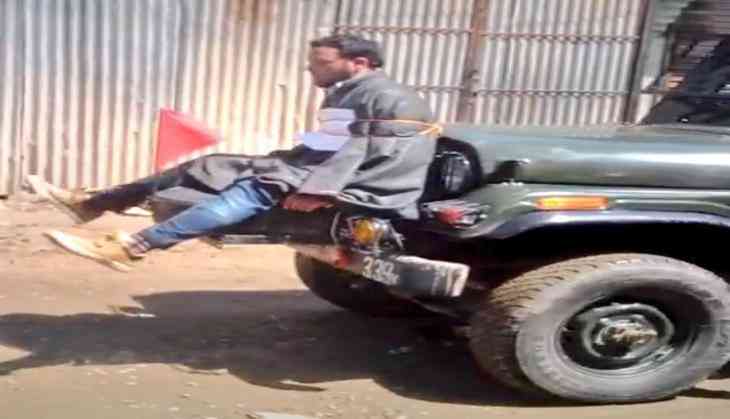Viral videos are now a bigger challenge to New Delhi than stone pelting in Kashmir

Dozens of videos highlighting atrocities by security forces are circulating on social media in Kashmir. And all of them have come up in reaction to the outrage generated across the country by a video in which Kashmiri youth are shown heckling CRPF jawans.
The main purpose of the videos being circulated now is to reassert the narrative that Kashmiris are the real victims of the conflict and not the security forces as the shrill media discourse around the ‘heckling video’ is seen to have suggested.
The videos followed in quick succession: Two of them showed Kashmiri villagers and stone pelters giving safe passage to the CRPF personnel caught among them. In another, a lone CRPF man is given safe passage.
“Go brother go,” the youth in the video are heard telling the CRPF personnel.
In another, the village elders are seen escorting a group of personnel to safety.
These videos are accompanied by ones that show the excesses employed by the forces. There are many of them doing the rounds of social sites. And more are being added by the day, each of them graphic in their violence.
One such video which competed for attention with the heckling video and almost neutralised its impact was one in which soldiers used a young man as a human shield against stone pelters. In the video, the man Farooq Dar is tied to the bonnet of a jeep to forestall the stone throwing as the security vehicles drive through the villages going to polls.
Another video shows a soldier slapping and hitting teenage boys held inside a security vehicle and forcing them to shout obscenities at Pakistan. One of the boys with his face bloodied by the beating is shown crying.
Yet another shows the forces similarly beating the three youths and forcing them to shout Pakistan Murdabad slogans and the other profanities at the country. Here again, one boy’s face is bloodied.
There are many more such videos that are being uploaded and shared every single day.
Solutions?
It was to stop these videos that the government had shutdown mobile and broadband internet services on polling days for Srinagar and Anantnag byelection scheduled for 9 April and 12 April. The expectation was that the consequent information vacuum will disconnect thousands of networked youth and facilitate voting.
But all these calculations went awry as eight youth were killed during the Srinagar bypoll when fearless youth marched towards polling booths. This forced the government to defer the Anantnag bypoll.
However, as soon as internet was restored, a barrage of videos flooded Facebook and Twitter and circulated on Whatsapp. Among the first to be uploaded was the one showing the CRPF personnel being heckled, filmed by an unknown youth who was a part of the crowd.
It was soon picked up by the sections of national media, particularly television channels, some of which followed it up by airing hysterical discussions over the humiliation of the soldiers.
“The video was apparently put online by youth to show off some bravado. That they could defeat the soldiers wielding guns with stones and still let them go,” said columnist Naseer Ganai.
“But some television channels, as usual, put a spin on this. Except for one youth who hits at the sleeping bag of one CRPF personnel, all others are heard exhorting one another not to beat them and let them go as they are poor people.”
New challenges
However, if anything, the videos on social media have confronted the security establishment with a new challenge in the Valley. Mobile phones with camera and internet have given people the power to record security operations and instantly upload them to social media.
In a matter of minutes, these videos go viral, generating public outrage where security personnel are shown torturing the youth and a sense of triumph where youth are forcing the personnel on the defensive by stone-pelting.
For every knot of youth throwing stones or protesting, there are many who are filming the whole scene.
Most of these videos not only become a source of embarrassment for the forces but also deepen the alienation on the ground.
“Their circulation doesn’t remain limited to the Valley only. They are seen across India and Pakistan. Besides, the Kashmiri and Pakistani diaspora circulates these around the world,” says PDP leader Abdul Wahid Parra.
“So, what is happening on a remote street in Kashmir and would ordinarily not have been known beyond a few eye-witnesses comes to the knowledge of millions of people. A humiliation and torture of one boy becomes the humiliation of all Kashmir.”
And similarly, the video of the heckling of one security personnel horrifies a larger section of people in the rest of India, generating frenzied television debates which become a cause of more anger in the Valley where people see these as something that is inherently biased against them.
“Social media videos have thus emerged as a new weapon in the conflict in Kashmir. And the problem is there is little defence against it,” says Naseer.
“Only option available is a permanent shutting down of internet”.
Edited by Jhinuk Sen
First published: 17 April 2017, 14:21 IST
